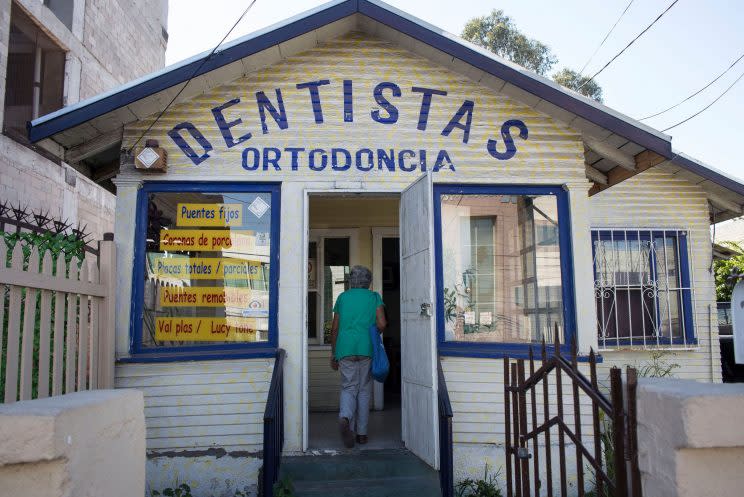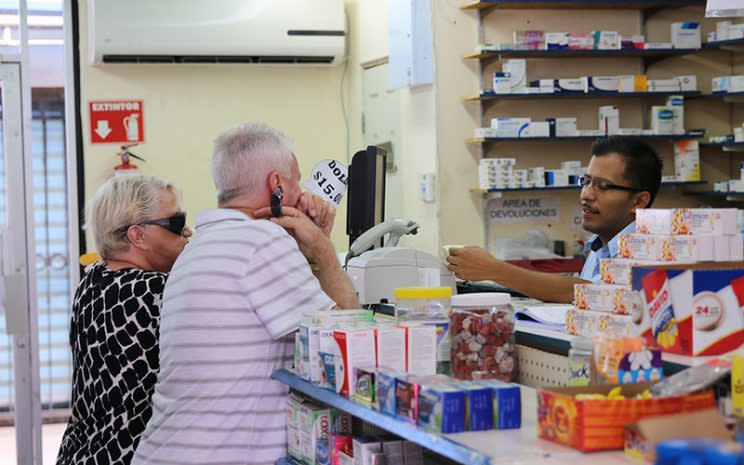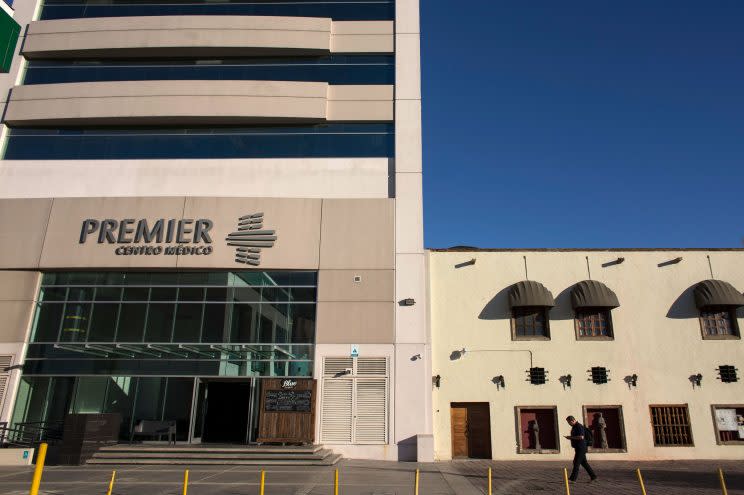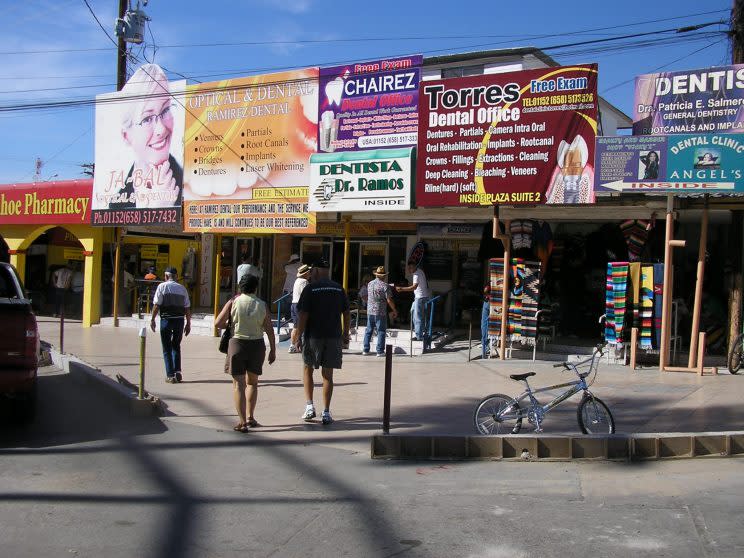A boom in medical tourism to Mexico predicted if Obamacare ends

On almost any weekday afternoon, silver-haired Americans, often with mouths still numb from Novocain, line up at the U.S. port of entry between Nogales, Mexico, and Nogales, Ariz.
Because Medicare offers virtually no coverage for dental work, Mexican border towns like Nogales have become go-to destinations for affordable, quality dental care among seniors and snowbirds from southern Arizona, California, and Texas. Less than 10 miles from the popular retirement hub of Yuma, Ariz., more than 350 dentists have set up shop in the small Mexican town of Los Algodones — earning it the nickname “Molar City.”
In recent years, rising medical costs compounded by the introduction of stingy federal exchange plans under the Affordable Care Act have begun to force more Americans to follow the path forged by snowbirds and migrate south of the border in search of affordable health care.
As a result, Mexico has quickly emerged as a world leader in medical tourism, luring an estimated 1 million patients each year, many of them from the U.S. — not just with cheap pharmaceuticals and dental services but also a range of procedures, from heart surgeries to in vitro fertilization and cancer treatments. They can receive care by specialists at high-quality hospitals and clinics for a fraction of the cost in the States.
Now, as Congress considers a new federal health care law predicted to leave approximately 24 million Americans uninsured by 2026, Mexico’s burgeoning health care industry ironically stands to be among the Republican bill’s biggest beneficiaries.
“Clearly this legislation will set the stage for increased out-of-country care,” said Patrick Goodness, CEO of the Goodness Co., a medical tourism marketing and public relations firm that works with a variety of international hospitals, medical centers and dental clinics.
Though difficult to predict exactly how many Americans will travel outside the U.S. for medical or dental care as a result of the Republican’s proposed American Health Care Act, Goodness told Yahoo News that he’s seen medical tourism from the U.S. steadily increase since 2013, with cost being the biggest driving factor.
“By nearly all accounts the U.S. medical system is broken,” Goodness said. “Sky-high hospital bills and staggering prices for pharmaceuticals push many Americans to seek care south of the border.”

Prior to the enactment in 2003 of the Medicare prescription drug subsidy program, known as Medicare Part D, it was Mexico’s inexpensive (and loosely regulated) pharmacies that first drew many Southwesterners across the border. There, they soon discovered an untapped trove of low-cost dental clinics.
“Word of mouth travels very quickly in this age demographic,” said Ron Vinluan, co-founder of Dayo Dental, a Phoenix-based company that helps connects patients with a vetted network of top dentists throughout Mexico.
Vinluan told Yahoo News that Dayo Dental has seen “20 percent healthy growth per year” since the company was founded in 2006. Sixty percent of patients who use Dayo Dental are older than 60, largely retirees living in the Southwest, but it serves Americans of all ages from all states as well as Canada. One study found that, as of 2014, 205 million Americans had no dental benefits.
While dentistry remained the area of largest growth for medical travel from the U.S. last year, Patients Beyond Borders, an organization dedicated to researching international trends in medical tourism, estimated that approximately 1.4 million Americans sought some sort of medical or dental care outside the U.S. in 2016.
Patients Beyond Borders CEO Josef Woodman credits the Affordable Care Act with helping drive this trend by forcing people to make choices about their insurance for the first time, leading many to pick seemingly inexpensive “skinny plans” that left many underinsured.
“Outbound medical tourism is not about rich people,” said Woodman. “It’s really people who are one medical condition away from the streets.”
Rising costs combined with limited choices for coverage, he said, create a “slippery slope that favors medical tourism, especially if you’re in Texas, California, Arizona, on the border.”
Anecdotally, Woodman said he’s observed a spike in traffic to PBB’s website since Republicans seized control of the White House and Congress, promising to repeal and replace Obamacare.
“I don’t think there’s any question that people are going to be pursuing more choices” if AHCA is passed, Woodman said.
“The way I see it, AHCA is a component of a larger trend toward people seeking global options in their health care,” said Woodman, who, along with Goodness and Vinluan, pointed to anecdotal signs of increased interest in their services from a growing number of younger Americans.
It’s this tech-savvy sector of the population who, they predict, will usher in the next phase of medical tourism by approaching health care with the same scrupulous, consumer-review-oriented techniques used to shop for airfare, apartments, cars, clothing and virtually everything else. In addition to curated online networks like Dayo Dental and the Goodness Company’s LosAlgodonesMedicalGuide.com, and the latest edition of Woodman’s “Patients Beyond Borders” paperback guide to international medical travel, prospective patients are starting to be able to find consumer reviews for Mexican doctors and dental clinics on sites like Trip Advisor and Yelp.
Woodman expects Mexico to continue to benefit from this trend. He said that when he first began researching medical tourism trends in 2005, the Joint Commission International (JCI), the global branch of a nonprofit health care accreditation service, had bestowed its seal-of-quality approval on only 27 institutions worldwide—none of which were in Mexico.
As of March 1, 2017, there were 900 JCI-accredited facilities around the globe, a number expected to reach 1,000 by 2018. Mexico is currently home to seven.
In 1999, the General Health Council of Mexico, a division of the Ministry of Health, decided to align its accreditation standards for hospitals, clinics, rehab centers and other health care facilities with international standards used by the JCI. According to the Medical Tourism Association, 126 private hospitals have since been certified by the General Health Council, with 238 more in the process.
Mexico’s move toward American-style hospitals and medical centers, coupled with its close proximity to the U.S. and relatively few restrictions for international patients, make it a desirable destination for American patients.
Americans who go abroad for care — overwhelmingly to Mexico — spend an average of $4,200 on services that cost 36 to 89 percent less than the U.S. equivalent. The Medical Tourism Association also estimates that Mexico generated $3.1 billion in revenue from medical tourism in 2014.
American companies are also getting in on the action. Last spring, San Diego’s Scripps Health system announced it was teaming up with Mexican health care provider SIMNSA on the construction of a full-service, binational hospital in Tijuana.
“We live in a binational region where thousands of people cross the border between San Diego and Tijuana daily for work,” Scripps president and CEO Chris Van Gorder said at the time. “Access to high quality health care on both sides of the border is important for our regional economy.”
Scripps’ cross-border venture follows a trend led by other American companies, such as Dallas-based International Hospital Corp. and Christus Health, whose networks both include several hospitals in Mexico.

“Binational health care is something that’s here to stay,” Van Gorder said at the time.
But while proponents of medical tourism are excited about the industry’s prospects for growth, not everyone is content to let Mexico become the preferred health care provider of the United States.
Rep. Ruben Gallego, D-Ariz., agreed that AHCA will likely lead to “increased travel to Mexico for some services that are found there cheaper, including dental work, some types of basic surgery, prescriptions.” But, he insisted, “it’s not an easy solution to go to Mexico” for senior citizens who may be too old, ill or impoverished to easily undertake the trip.
Already at the forefront of the medical tourism trend, Arizona this year was hit with the biggest insurance premium hikes of any state on the federal Obamacare exchange, with premiums predicted to rise by an average of 116 percent statewide in 2017.
However, thanks to subsidies provided under the Affordable Care Act, the hikes actually had little impact on the wallets of most Arizonans with Obamacare plans.
“When premiums went up last year, there wasn’t much of a rush to Mexico … because [there were] subsidies to match it,” said Gallego. “If anything, [it was] just political fodder for Republicans.”
Shortly before the election, news of projected premium hikes became talking points for the campaigns of Arizona GOPers like Sen. John McCain and newly elected Rep. Andy Biggs, who both pledged to repeal Obamacare. Since then, Republicans including House Speaker Paul Ryan and President Trump have continued to use Arizona’s astronomical premiums as a cautionary tale to promote their proposed ACA replacement.
But it’s the AHCA, in particular its provision to roll back the ACA’s Medicaid expansion, that Gallego fears will drive “more older, working, poor people from Arizona,” a Medicaid expansion state, to seek alternative health care options in Mexico — or worse, not at all.
“Most seniors can’t drive that far at this point, and if you’re that poor, can you afford trips to Mexico to get surgery [or] to get prescriptions?” he asked. He predicted that many of those slated to become uninsured under AHCA will likely “avoid any type of medical service until it becomes an emergency and then they’ll go to the emergency room, which ends up being more costly to them and to taxpayers.”

McCain and Biggs have both expressed concerns about the proposed Obamacare replacement bill, though neither responded to requests for comment from Yahoo News.
Even if Republicans manage to revise the legislation in a way that causes less overt damage to their key voter base, it would likely do little to block the migration toward medical tourism already in motion.
Like any industry disruptor, medical tourism is seen by proponents as more than just an alternative to the increasingly unaffordable cost of health care in the U.S., but as a potential force for systemic change.
“I truly believe the phenomenon of people going to other countries for affordable care will help deflate rising medical costs,” said Vinluan.
Goodness agreed.
“The simple truth is this,” he said. “If Americans could secure affordable comprehensive medical insurance coverage — even with preexisting conditions — there would be a reduced incentive to travel for medical care.”
Correction: An earlier version of this story stated that ‘Mexico is home to 900 JCI-accredited facilities, a number expected to reach 1,000 by 2020.’



